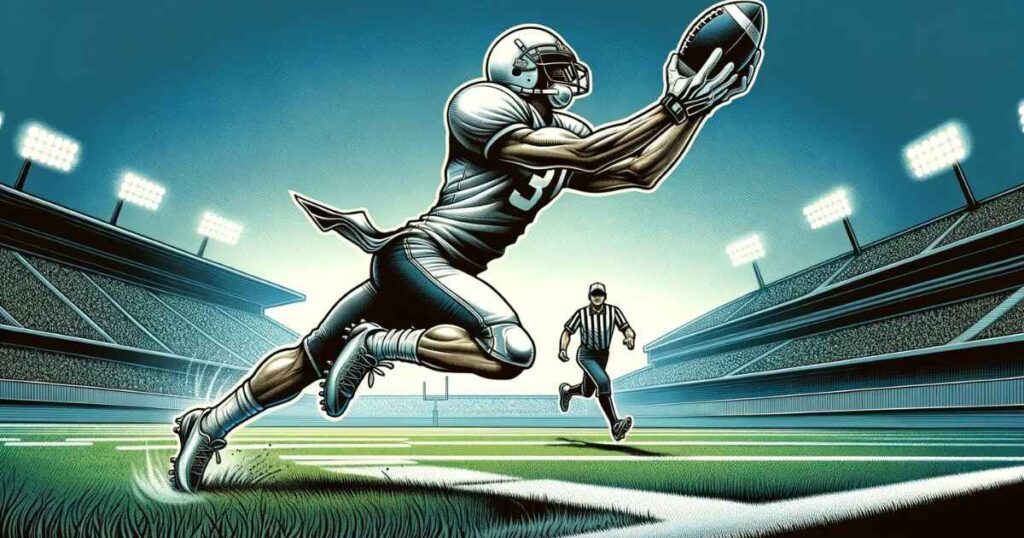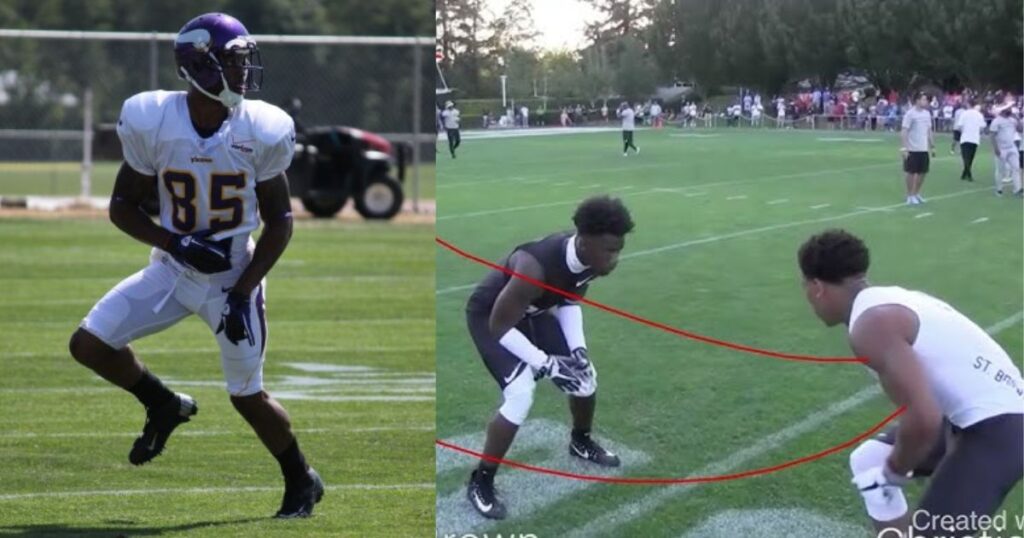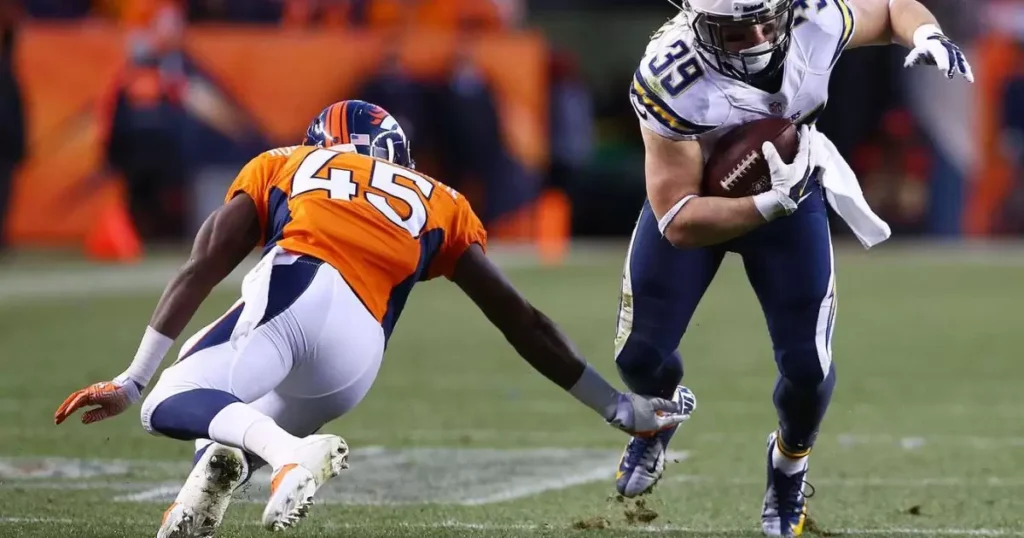A reception in football occurs when a receiver catches a pass from the quarterback. The receiver must have clear possession of the ball and maintain control while in bounds. Receptions are key to advancing the ball down the field and scoring. They can be made by wide receivers, tight ends or running backs.
A successful reception requires precise timing, good hands, and awareness of defenders. If the ball is caught but the player steps out of bounds or drops it. The catch is incomplete. Receptions are tracked as a statistic and are crucial in evaluating a player’s performance. The ability to consistently make receptions can significantly impact the outcome of a game.
The Role of the Receiver in Football
Wide receivers and tight ends are the primary pass catchers in football. These athletes are the speed demons and acrobats of the gridiron, tasked with outmaneuvering defenders and securing the ball.
Wide receivers, often positioned on the outer edges of the formation, use their speed and agility to run precise routes and create separation from defenders.Tight ends, on the other hand, are versatile players who line up closer to the offensive line. They’re not just pass catchers but also valuable blockers.
Their ability to switch between these roles makes them unpredictable weapons in a team’s offensive scheme. Both types of receivers must possess not only physical prowess but also mental sharpness to read defenses and adjust their routes on the fly.
Quarterback to Receiver

The connection between a quarterback and receiver is like a well-choreographed dance. It’s all about timing, trust, and countless hours of practice. The quarterback must read the defense, anticipate where the receiver will be, and deliver the ball with pinpoint accuracy – often while under pressure from rushing defenders.
For the receiver, it’s about running the right route, finding open space, and having the hands to make the catch. This synergy between quarterback and receiver is cultivated through rigorous practice and game experience. When it clicks, it’s a thing of beauty – a successful grab that can leave defenders in the dust and fans roaring with excitement.
Types of Receptions
Receptions come in all shapes and sizes, each with its own strategic purpose. Short passes like quick slants or bubble screens are designed to gain quick yardage or evade high-pressure situations.
These plays often rely on the receiver’s ability to make defenders miss and gain yards after catch.On the flip side, downfield passes are the home run hitters of the passing game.
These long throws require a strong arm from the quarterback and lightning speed from the receiver. When successful, these plays can dramatically shift the momentum of a game, turning a defensive struggle into an offensive shootout in the blink of an eye.
Read More: Why Important to Understand Volleyball Net Height & Flooring
The Rules Surrounding Receptions
The NFL and other football leagues have specific rules governing what constitutes a legal reception. For a catch to count, the receiver must have control of the ball and get both feet (or any other part of the body besides the hands) in bounds.
They must also maintain control of the ball throughout the process of going to the ground.These reception guidelines can lead to some nail-biting moments, especially on sideline receptions or diving catches.
Officials scrutinize these plays closely often using slow-motion replays to determine if it is a successful reception or an incomplete pass. The difference can be a matter of inches or split seconds adding to the drama and excitement of the game.
Receptions in Different Football Leagues

While the basic concept of a reception remains consistent across football leagues, there can be subtle differences in rule interpretations and enforcement. The NFL, for instance, might have slightly different criteria for what constitutes a catch compared to collegiate football or high school leagues.
In professional leagues like the NFL, the scrutiny on receptions is intense, with high-definition cameras and instant replay technology allowing officials to analyze catches frame by frame.
This level of detail can sometimes lead to controversial calls that spark debate among fans and analysts alike. Meanwhile, in amateur leagues, the focus might be more on the spirit of the rule rather than its letter, leading to a slightly different playing experience.
Famous Reception Plays in Football History
Some receptions have etched themselves into football lore, becoming the stuff of legend. Take, for example, the “Immaculate Reception” by Franco Harris in the 1972 AFC Divisional Playoff game. This miraculous catch off a deflected pass led to a game-winning touchdown for the Pittsburgh Steelers, cementing its place in NFL history.
More recently, plays like Odell Beckham Jr.’s one-handed catch in 2014 have redefined what seems physically possible on the football field. These iconic moments showcase the incredible athleticism and skill required to make game-changing receptions, often under immense pressure. They remind us why the reception remains one of the most exciting plays in football.
Techniques and Drills
Mastering the art of reception requires dedication and countless hours of practice. Receivers work tirelessly on drills to improve their hand-eye coordination, route running and timing. One popular drill is the “gauntlet,” where receivers run across the field, catching passes from multiple directions in rapid succession.
Another crucial aspect is developing ball control and the ability to make clean catches in traffic. Receivers practice snatching the ball out of the air with their fingertips, rather than letting it hit their body. This technique, known as “hand catching,” allows for quicker control and reduces the chance of the ball being knocked away by a defender.
Analyzing Statistics: What Do They Tell Us?

In today’s data-driven sports world reception statistics provide valuable insights into a player’s performance and a team’s offensive strategy. Key metrics include:
| Statistic | Description |
| Receptions | Total number of successful catches |
| Receiving yards | Total yards gained from receptions |
| Catch percentage | Percentage of targets resulting in receptions |
| Yards After Catch (YAC) | Yards gained after catching the ball |
| Reception touchdowns | Touchdowns scored from receptions |
These stats help coaches and analysts evaluate receiver performance, plan game strategies and even make decisions about player contracts and drafts. For fantasy football enthusiasts these numbers are golden forming the basis for player rankings and predictions.
Also See: How Many Laps Will It Take Around a Basketball Court to Equal a Mile?
The Future of Receptions in Football: Evolving Strategies and Trends
As football continues to evolve so too does the role of receptions in the game. We are seeing a trend towards more pass-heavy offenses with teams relying increasingly on short quick passes to move the ball efficiently. This shift has led to the rise of slot receivers who excel at running precise routes in the middle of the field.
Technology is also playing a bigger role with advanced analytics helping teams optimize their passing game. Coaches are using data to design more effective pass patterns and route combinations. Meanwhile, innovations in training techniques and equipment are helping receivers push the boundaries of what is possible on the field.
The Mental Game: Honing Football IQ
Football IQ is just as crucial as physical skills when it comes to successful receptions. Receivers must be able to read defenses on the fly, recognize coverage schemes and adjust their routes accordingly. This mental acuity is what separates good receivers from great ones.
Developing this football intelligence involves studying film, understanding defensive tendencies and learning to communicate non-verbally with the quarterback. It is about anticipating where the gaps in the defense will be and having the instinct to find them. This mental aspect of the game is why veteran receivers often remain effective even as their physical skills begin to decline.
Mastering the Intricacies of Route Running

Route running is an art form in itself. It is not just about running in a straight line or making a simple turn. Receivers must master a complex route tree that includes various patterns like slants, posts, corners and fades. Each route requires precise footwork, timing, and the ability to sell fake moves to defenders.
Great route runners use subtle body movements to deceive defenders. A slight head fake or a quick stutter step can create just enough separation to make a catch possible. This skill is particularly important in tight end play where players often need to create space in congested areas near the line of scrimmage.
The Importance of Practice and Preparation
Behind every spectacular catch on game day are countless hours of practice and preparation. Receivers spend time working on their catching technique, running routes until they are second nature and building chemistry with their quarterbacks.
This preparation extends beyond the field to the film room where players study opponent tendencies and game plans.Teams often use sophisticated practice techniques to simulate game conditions.
For instance, some receivers practice catching passes while wearing strobe glasses that intermittently block their vision, helping them focus on the ball in challenging conditions. Others use virtual reality technology to practice reading defenses and running routes without the physical wear and tear of on-field practice.
The Science and Data Behind Receiving
Modern football has embraced data analytics to optimize receiving performance. Teams use advanced metrics like catch percentage, yards after catch (YAC) and reception touchdowns to evaluate players and inform strategy. GPS tracking during practices and games provides insights into player movements helping coaches design more effective plays.
Biomechanics also plays a role with teams studying the physics of catching to help players optimize their techniques. This scientific approach extends to equipment design, with gloves and cleats engineered to provide the best possible grip and traction for receivers.
Frequently Asked Questions
What is a reception in football?
A reception happens when a receiver catches a forward pass from the quarterback.
What is the reception rule in football?
For a legal reception the receiver must control the ball fully while getting two feet inbounds.
What are player receptions in football?
Player receptions refer to the total number of passes an individual receiver successfully catches.
What does total reception mean?
Total receptions is a stat measuring how many catches a receiver makes over a game or season.
What is the purpose of a reception?
Receptions help offenses gain yards and score points by advancing the ball downfield through the air.
Conclusion
Receptions are more than just catching a ball. They are a complex interplay of physical skill, mental acuity and teamwork. From the quick slants that keep the chains moving to the breathtaking deep balls that bring fans to their feet, receptions are at the heart of football’s excitement.
As the game continues to evolve, one thing remains certain. The art of the reception will always be a crucial element in the quest for gridiron glory. You are a die-hard fan or a casual observer understanding the intricacies of receptions can deepen your appreciation for this thrilling aspect of America’s favorite sport.

